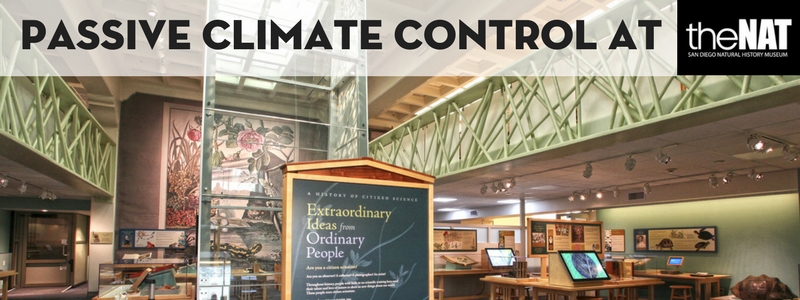The San Diego Natural History Museum (theNAT) has been working on a unique energy saving and collection preserving project that culminated with the opening of Extraordinary Ideas from Ordinary People: A History of Citizen Science in the fall of 2016. This permanent exhibit features a multitude of historic documents, photos and other delicate artifacts. The logistics of opening this exhibit took into account the strict guidelines for displaying delicate paper artifacts while focusing on one sustainability initiative in particular set forth by the International Council of Museums Conference in Melbourne in 2014, “Care of collections should be achieved in a way that does not assume air conditioning (HVAC). Passive methods, simple technology that is easy to maintain, air circulation and lower energy solutions should be considered.”
New technology is always emerging in the sustainability field and museums can and should be at the forefront. Temperature, humidity, and light levels are all important factors to museums because they need to be well regulated to protect valuable collections. These are some of the passive climate control elements that theNAT has implemented:
- Insulated window panels
- Rechargeable desiccant cassettes
- Shade cloths
The insulated window panels that were installed on skylights and windows stabilize the temperature and light in the gallery without using central heating and cooling systems. Not only do the panels provide temperature and light regulation, but they also fortify the historic building by creating a vault-like structure. Desiccant cassettes are small devices that are installed inside display cases to regulate humidity, protect against corrosion, control condensation, and protect against mold and mildew. This small device saves energy by creating a stable micro-climate in each case – keeping documents in near perfect conditions. One of the cassettes most valuable attributes is the ease of maintenance. The silica mineral inside can be “recharged” every six months by sun-drying or using a microwave oven giving the cassettes longevity for years to come. Industrial shade cloth was added over select display cases that needed extra protection from light. None of these modifications required the use of additional electricity.
Historic buildings offer unique challenges that require creative problem solving. TheNAT’s building was built in the 1930’s and bears more than 1,400 square feet of single pane glass windows. This is not the most thermally ideal situation, as heat escapes and cold air permeates more easily, creating an unstable indoor environment requiring variable heating and cooling, which in turn uses loads of energy. Adding thermal window insulation panels is a passive and cost effective way to save energy without replacing the historic windows.
A common thread in museums and nonprofits is finding a financial balance between building operations, staffing and programming costs. TheNAT recognizes the importance of saving money through energy savings, so that staff and programming is not sacrificed. Saving energy is a huge step in implementing best practices that contribute to conservation and sustainability efforts worldwide. The principle, “think globally, act locally” resonates through theNAT’s sustainability efforts and mission to preserve scientific records for future generations.
Guests and employees of theNAT subtly benefit from the passive climate control features through comfortable ambient conditions and well-cared and preserved collections and exhibits. TheNAT looks forward to sharing the resources and models associated with this project with other organizations, so that sustainable practices can be a widespread and manageable movement. TheNAT proves that historical buildings can be sustainable through low cost and easy to maintain techniques.

